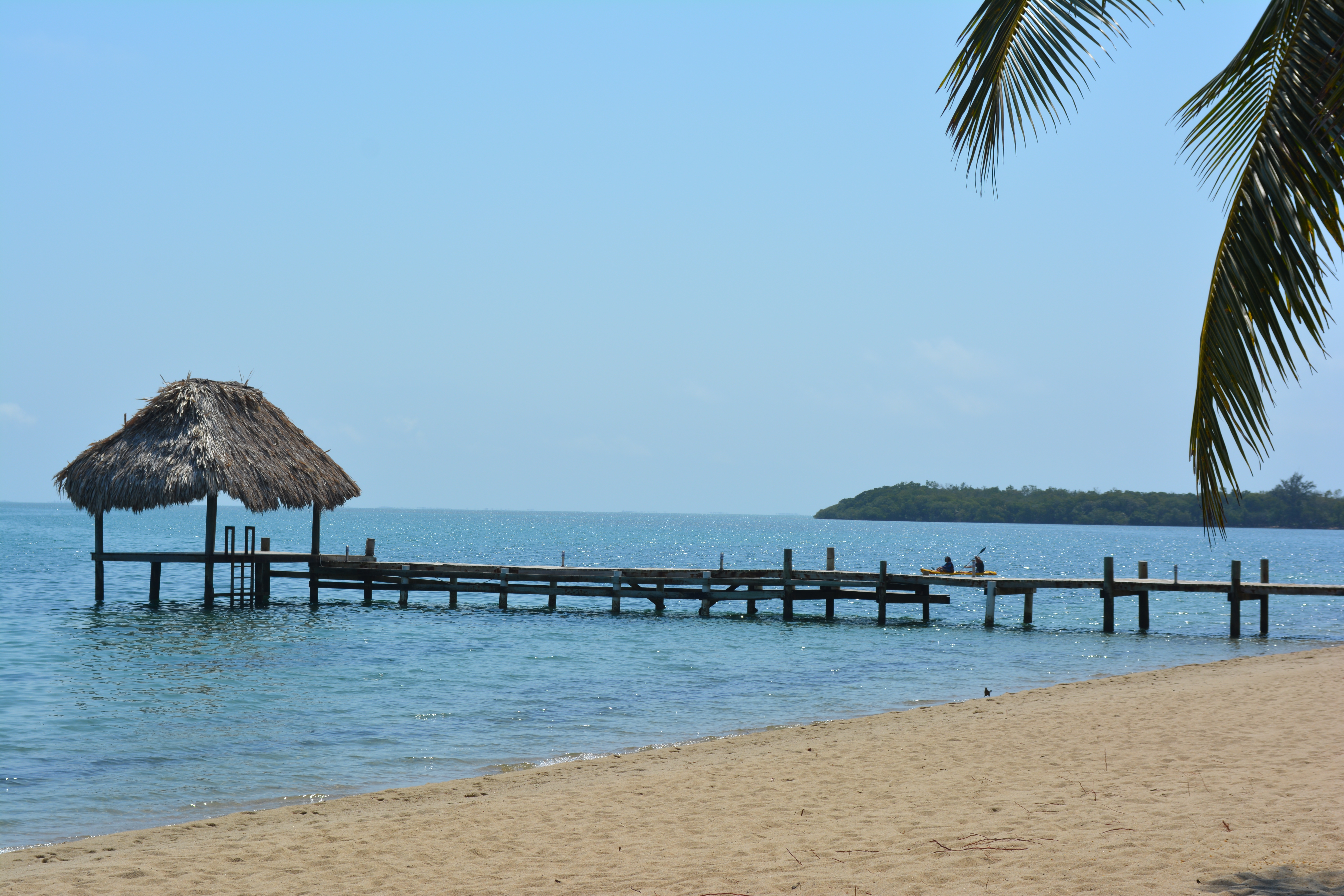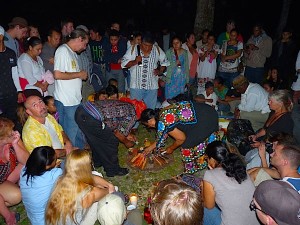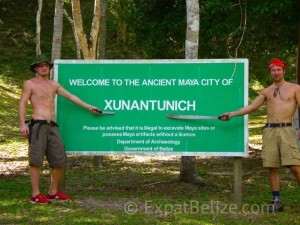Maya Ruins of Belize
The Maya ruins of Belize include a number of well-known and historically important pre-Columbian Maya archaeological sites. Belize is considered part of the southern Maya lowlands of the Mesoamerican culture area, and the sites found there were occupied from the Preclassic until and after the arrival of the Spanish.
Actun Tunichil Muknal
As a Maya archaeological site, ATM is notable for its skeletons, ceramics, and stoneware. The most famous of the human remains is known as “The Crystal Maiden”. It is the skeleton of a teenaged girl, probably a sacrifice victim, the bones of which have been completely covered by the natural processes of the cave, leaving them with a sparkling appearance. There are several such skeletons in the Main Chamber.
The ceramics at the site are significant partially because they are marked with “kill holes”, which indicates they were used for ceremonial purposes.
The cave is also an important tourist site, with guided tours. This site is featured on National Geographic’s Top Ten things to do before you die and is located in the Cayo District of Belize.
To view a picture gallery of the ATM cave click here: Belize ATM Gallery
Altun Ha
Altun Ha is the name given ruins of an ancient Maya city in Belize, located in the Belize District about 30 miles (50 km) north of Belize City and about 6 miles (10 km) west of the shore of the Caribbean Sea.
“Altun Ha” is a modern name in the Maya language, coined by translating the name of the nearby village of Rockstone Pond. The ancient name is at present unknown.
Temple of the Masonry Altars
The largest of Altun Ha’s temple-pyramids, the “Temple of the Masonry Altars”, is 54 feet (16 m) high. A drawing of this structure is the logo of Belize’s leading brand of beer, “Belikin”.
The site covers an area of about 5 miles (8 km) square. The central square mile of the site has remains of some 500 structures.
Archeological investigations show that Altun Ha was occupied by 200 BC. The bulk of construction was from the Maya Classic era, c. 200 to 900 AD, when the site may have had a population of about 10,000 people. About 900 there was some looting of elite tombs of the site, which some think is suggestive of a revolt against the site’s rulers. The site remained populated for about another century after that, but with no new major ceremonial or elite architecture built during that time. After this the population dwindled, with a moderate surge of reoccupation in the 12th century before declining again to a small agricultural village.
The ruins of the ancient structures had their stones reused for residential construction of the agricultural village of Rockstone Pond in modern times, but the ancient site did not come to the attention of archeologists until 1963, when the existence of a sizable ancient site was recognized from the air by pilot and amateur Mayanist Hal Ball.
Starting in 1965 an archeological team lead by Dr. David Pendergast of the Royal Ontario Museum began extensive excavations and restorations of the site, which continued through 1970. One of the most spectacular discoveries is a large (almost 10 pounds or 5 kilograms) piece of jade elaborately carved into an image of the head of the Maya Sun God, Kinich Ahau. This jade head is considered one of the national treasures of Belize.
A road (which is known as the Old Northern Highway) connects Altun Ha to Belize’s Northern Highway in the Corozal District, and the site is accessible for tourism.
Cahal Pech
Cahal Pech is a Maya site located near the Town of San Ignacio in the Cayo District of Belize. The site was a palacio home for an elite Maya family, and though most major construction dates to the Classic period, evidence of continuous habitation has been dated to as far back as far as 900 BC during the Early Middle Formative period (Early Middle Preclassic), making Cahal Pech one of the oldest recognizably Maya sites in Western Belize. The site rests high near the banks of the Macal River and is a collection of 34 structures, with the tallest being about 25 meters in height. The site was abandoned in the 9th century AD for unknown reasons.
The name Cahal Pech, meaning “place of ticks”, was given when this site was a pasture during the first archaeological studies in the 1950s. It is now an archaeological park, and houses a small museum with artifacts from various ongoing excavations.
Caracol
Perhaps the most important, Caracol (‘the snail’ in Spanish), is located in western Belize, near the border with Guatemala and within the Belizean part of the Peten rainforest. Caracol was the center of one of the largest Maya kingdoms and today contains the extant remains of thousands of structures. The city was an important player in the Classic period political struggles of the southern Maya lowlands, and is known for defeating and subjugating Tikal (while allied with Calakmul, located in Campeche, Mexico). Caracol is located in the Cayo District of Belize.
Cerros
The site of Cerros, located on Chetumal Bay in northern Belize, is notable as one of the earliest Maya sites, reaching its apogee during the Late Preclassic on Chetumal Bay, and for the presence of an E-Group, a unique structural complex found in Maya architecture. Cerros is located in the Corozal District of Belize.
El Pilar
El Pilar is the name given to ruins of an ancient Maya city in Belize, located in the Cayo District straddling the Belize-Guatemala border, 12 miles (19 km) north-west of the town of San Ignacio. It is the largest site in the area with over 25 plazas and covering around 50 hectares. Little archaeological work has been undertaken, but there is a series of trails allowing access to the site. In 1997 El Pilar was listed on World Monument Fund’s 100 Most Endangered Sites in the World. It is managed as an Archaeological Reserve for Maya Flora and Fauna.
Lamanai
Lamanai, located on the New River in Orange Walk District, is known for a the longest continually-occupied site in Mesoamerica. The initial settlement of Lamanai occurred during the Early Preclassic, and it was continuous occupied up to and through the colonization of the area. During the Spanish conquest of Yucatán, the conquistadores established a Roman Catholic church at Lamanai, but a native Maya revolt drove them away. The extant remains of the church are still standing today.
Louisville
Louisville is a town in the Corozal District of the nation of Belize, located at 18°19’N, 88°30’W. According to the 2000 census, it had a population of 655 people.
Some substantial artificial mounds at Louisville are the remains of an ancient city of the Maya civilization. The site seems to have been occupied from about 400 BC to about 950 AD. Excavations were made here by Dr. Thomas Gann in the mid 1930s, uncovering some interesting polychrome stucco portrait heads.
Much of the ancient remains were demolished to reuse stone and make fill for roads. Further investigations and excavations of Louisville were made in 2000.
Lubaantun
Lubaantun (sometimes spelled Lubaantún) is a Pre-Columbian ruined city of the Maya civilization in southern Belize, Central America. Lubaantun is in Belize’s Toledo District, about 26 miles northwest of Punta Gorda, about two miles from the village of San Pedro Columbia, at 16°16’52″N, 88°57’54″W at an elevation of 200 feet above sea level. One of the most distinguishing features of Lubaantun is the large collection of miniature ceramic objects found on site; these detailed constructs are thought to have been charmstones or ritual accompanying acoutrements.
The city dates from the Maya Classic era, flourishing from the 730s to the 890s AD, and seems to have been completely abandoned soon after. The architecture is somewhat unusual from typical Classical central lowlands Maya sites. Lubaantun’s structures are mostly built of large stone blocks laid with no mortar. Several structures have distinctive “in-and-out masonry”; each tier is built with a batter, every second course projecting slightly beyond the course below it. Corners of the step-pyramids are usually rounded, and lack stone structures atop the pyramids; presumably some had structures of perishable materials in ancient times.
The centre of the site is on a large artificially raised platform between two small rivers; it has often been noted that the situation is well suited to military defense. The ancient name of the site is currently unknown; “Lubaantun” is a modern Maya name meaning “place of fallen stones”.
Nim Li Punit
Nim Li Punit, is a Maya Classic Period site in the Toledo District of the nation of Belize, located 40 kilometres north of the town of Punta Gorda, at 16° 19′ N, 88° 47′ 60W. Nim Li Punit is sometimes known as Big Hat or Top Hat; the name is Kekchi Maya language for “Big Hat”, referring to the large elaborate head-dress on a stela sculpture found on site depicting one of the site’s ancient kings.
Nim Li Punit is a medium sized site from the Maya Classic Period, flourishing from the 5th century AD through the 8th century AD. It consists of structures around three plazas, including several step-pyramids, the tallest being 12.2 meters high. The site has a number of carved stelae illustrating the ancient city’s rulers. Several stelae are in an unfinished state, suggesting a sudden halt to work. The site is near Belize’s Southern Highway and is open to visitors subject to an admission charge.
Xunantunich
Xunantunich (shoo-NAHN-too-nich) is a Maya archaeological site in western Belize, about 80 miles (130 km) west of Belize City, in the Cayo District. Xunantunich is located atop a ridge above the Mopan River, within sight of the Guatemala border. Its name means “Stone Woman” in the Maya language (Mopan and Yucatec combination name), and, like many names given to Maya archaeological sites, is a modern name; the ancient name is currently unknown. The “Stone Woman” refers to the ghost of a woman claimed by several people to inhabit the site, beginning in 1892. She is dressed completely in white, and has fire-red glowing eyes. She generally appears in front of El Castillo; ascends up the stone stairs and disappears into a stone wall.
Most of the structures date from the Maya Classic Era, about 200 to 900. There is evidence that some structures were damaged by an earthquake while they were occupied; this earthquake may have been a reason for the site’s abandonment.
The core of Xunantunich occupies about 1 square mile (2.6 km²), consisting of a series of 6 plazas surrounded by more than 26 temples and palaces. One of its structures, the pyramid known as “El Castillo,” the second tallest structure in Belize (after the temple at Caracol), at some 130 feet (40 m) tall. Archeological excavations have revealed a number of fine stucco facades on some of the ancient temples of this site. Evidence of construction suggests the temple was built in three stages in the 600s AD, 700s AD, and 800s AD. The fine stucco or “frieze” are located on the final stage.
The first modern explorations of the site were conducted by Thomas Gann in 1894 and 1895. Several projects of archeological excavations have been conducted at the site from the 1930s through the 1990s.
One of the best preserved ancient stelae is housed in a small weatherproofed building for conservation purposes. This artefact is a large stela dated within the period 200 BC to 150 AD; it depicts a Mayan figure facing left. The figure is striding and clothed only in armbands.









